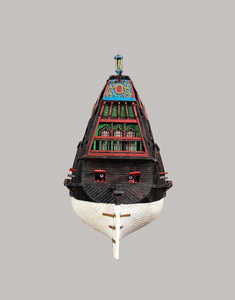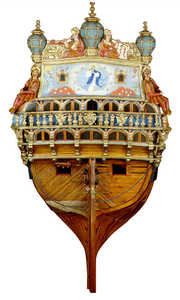The galleon. Sixteenth - Seventeenth centuries
At times of conflict Basque merchant vessels were requisitioned
by the crown and adapted for use in war.
Around the middle of the sixteenth century a type of ship
began to emerge, designed specifically for warfare.
Privateers and pirates posed a serious threat to the interests
of the Spanish Crown.
The galleon, a gigantic floating strongbox specifically devised
to protect gold and silver, was born out of this attempt
to preserve Spain’s monopoly on the Indies Run.
Armed with large numbers of guns, it was sturdy enough to
resist the impact of artillery fire and was longer than the
traditional nao to give it greater speed.
The galleon arose out of the concept of armed trade and for
the first time Basque shipbuilders were required by royal
ordinance to construct vessels to specific new proportions.

Detail of a map by Jodocus Hondius (1606). Legiones Biscaiae
et Guipuscoae typus (Mercator's World Atlas / Hondius). © José Lopez

The increase in the number of guns carried on board the
galleons, designed using the same geometric procedures that had
been applied to cargo vessels, caused problems due to the vast
weight of the cannons on the upper decks. Throughout the seventeenth
century trials were carried out to try to correct the problem,
with only limited success. © José Lopez

The increase in the number of guns carried on board the
galleons, designed using the same geometric procedures that had
been applied to cargo vessels, caused problems due to the vast
weight of the cannons on the upper decks. Throughout the seventeenth
century trials were carried out to try to correct the problem,
with only limited success. © José Lopez

Nuestra Señora de la Concepción y de las Ánimas, armed
with 90 guns. 500 carpenters from Gipuzkoa were employed in
building her. © José Lopez

Nao belonging to Joan de la Salde (the king's treasurer) built
in Orio in 1578 by master shipbuilder Antón de Yerobi to transport
goods on the “Indies Run”. The new charge of guarding the riches
brought back from the Americas led to modifications in the merchant
ships, which later evolved into what became the galleon. © José Lopez

In 1608, the Spanish Crown laid down mandatory proportions
for all ships built to operate on the Indies Run. This did not please
Basque shipbuilders, who argued that the new ships had less capacity than traditional ones, with their proven commercial success.
However, the defensive needs of the Crown prevailed, although the
ordinances were relaxed in 1613. © José Lopez

Evolution of stern transoms; from the defined outline of the
galleon to new forms leading to the ship-of-the-line. © José Lopez

Between 1687 and 1690 Antonio de Gaztañeta led the construction
of the royal flagship “Nuestra Señora de la Concepción y
de las Ánimas”. In his work “Arte de fabricar Reales” he describes
her construction in great detail. This large galleon was innovative
for her time, marking a transition from the galleon to the ship of the
line. © José Lopez

Increased solidity made the structure heavier, and the guns
added a further weight. This led to an increase in the length and the
sail area with the development of topgallant sails. These changes
were needed to make up for the added weight and increase the
speed of the ships. © José Lopez













